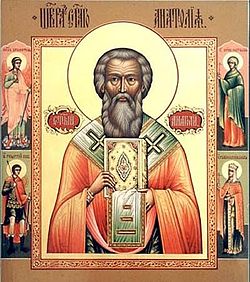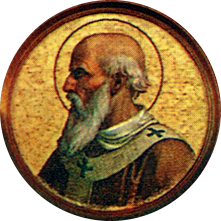Top Qs
Timeline
Chat
Perspective
July 3 (Eastern Orthodox liturgics)
From Wikipedia, the free encyclopedia
Remove ads
July 2 - Eastern Orthodox Church calendar - July 4

All fixed commemorations below are celebrated on July 16 by Old Calendar.[note 1]
For July 3rd, Orthodox Churches on the Old Calendar commemorate the Saints listed on June 20.
Saints
- Martyr Hyacinth the Cubicularius, of Caesarea in Cappadocia (108)[1][2][3][4][5][6][7][note 2][note 3]
- Saint Anatolius of Laodicea, Bishop of Laodicea, and his successor, St. Eusebius (3rd century)[1][11][12][note 4]
- Martyrs Mark and Mocius (4th century)[1][3][13][14][note 5]
- Saint Alexander, founder of the Monastery of the Unsleeping Ones ("the Ever-Vigilant"), Constantinople (c. 430)[1][11][15][16][17] (see also: January 15, February 23)
- Saint Anatolius, Patriarch of Constantinople (458)[1][3][11][16][18][19][20][21][22]
- Saint Isaias the Solitary, of Scetis and Palestine (491)[1][11]
- Saint Symeon the Stylite (the third stylite), of Cilicia (6th century)[1][11]
- Martyr Theodota (712)[3][23][24]
Remove ads
Pre-Schism Western saints
- Saint Dathus (Datus), Bishop of Ravenna in Italy (190)[25][26][note 6][note 7]
- Saints Irenaeus, a deacon, and Mustiola, a noble lady, martyred in Chiusi in Tuscany in Italy under Aurelian for ministering to other martyrs and burying their relics (273)[25][27][note 8]
- Saint Heliodorus of Altino, first bishop of Altinum (Altino) (c. 390)[24][25][28][note 9][note 10]
- St. Byblig of Carnarvon (Biblig, Peblig, Piblig, Publicius), Gwynedd, in Wales.[25]
- Saint Germanus, Bishop of the Isle of Man and Enlightener of Peel, nephew of St. Patrick of Ireland (474)[1][11][25][29][30][note 11]
- St. Bladus (Baldus), an early Bishop of the Isle of Man.[25]
- Saint Gunthiern, a prince in Wales who went to Brittany and lived as a hermit (c. 500)[25][note 12]
- Saint Leo II, Pope of Rome (683)[25][note 13]
- Saint Cilléne Droichtech, Abbot of Iona (c. 752)[25][32]
- Saint Guthagon, born in Ireland, he crossed to Belgium and became a hermit (8th century)[25][33][34]
Remove ads
Post-Schism Orthodox saints
- Saint George the Godbearer, of the Black Mountain, teacher of St. George of Mount Athos (1068)[1][11][35]
- Saint Basil the Bishop of Ryazan (1295)[1][11][16][24][36][37][note 14]
- Venerable Anatolius, recluse, of the Near Caves in Kiev (12th century)[1][3][11][16][38][39][note 15]
- Venerable Anatolius, recluse, of the Far Caves in Kiev (13th century)[1][11][16][40]
- Saints Basil (1249) and Constantine (1257), holy princes of Yaroslavl (13th century)[1][11][16][24][41]
- Saint Basil (Kalika or Koleka), Archbishop of Novgorod (1352)[1][11]
- Saints John and Longinus,[42] Wonderworkers of Yarensk, Solovki (1544-1545)[1][11][16][43]
- Blessed John of Moscow, Fool-for-Christ (1589)[1][11][16][44][45]
- Venerable Nicodemus of Khozyuga (Kozhe Lake), monk of Kozhaezersk Monastery (1640)[1][11][16][24][46]
- Blessed Michael, Herodion, Basil, and Thomas, Fools-for-Christ, of Solvychegodsk (17th century)[1][11][47]
- Saint Joachim the New Godbeaerer, of Notenon Monastery in Achaia (17th century)[1][3][24][48]
- Saint Euphrosine (Viaziemska) of Kolupanovo, Aleksin, Fool-for-Christ (1855)[49]
New martyrs and confessors
Other commemorations
- Icon of the Mother of God the "Milk-Giver" (Galaktotrophousa), of the Hilandar Monastery on Mount Athos.[1][52][53][54]
- Second translation (1652) of the relics of Hieromartyr Philip, Metropolitan of Moscow and all Russia (1569)[1][3][11][16][55][56][57]
- Uncovering of the relics (1959) of Hieromartyr Raphael of Lesbos (1463), in Mytilene.[24][58]
- Uncovering of the relics (2005) of Sylvester (Olshevsky), Bishop of Omsk (1920)[11][16][note 17] (see also: February 25)
- Repose of Nun Euphrosyne "the Unknown," of Kolyupanovo, Aleksin (1855)[1]
Remove ads
Icon gallery
- Relics of St. Hyacinth of Caesarea.
- St. Leo II, Pope of Rome.
- St. Basil the Bishop of Ryazan.
- Venerable Anatolius, recluse, of the Near Caves in Kiev.
- Blessed John of Moscow, Fool-for-Christ (right).
- New Hieromartyr Anthony (Bystrov), Archbishop of Arkhangelsk and Kholmogorsk.
- Icon of the Mother of God the "Milk-Giver" (Galaktotrophousa).
- Hieromartyr Philip, Metropolitan of Moscow and all Russia.
- St. Raphael of Lesbos.
- St. Sylvester (Olshevsky), Bishop of Omsk.
Remove ads
Notes
- The notation Old Style or (OS) is sometimes used to indicate a date in the Julian Calendar (which is used by churches on the "Old Calendar").
The notation New Style or (NS), indicates a date in the Revised Julian calendar (which is used by churches on the "New Calendar"). - "At Caesarea, in Cappadocia, St. Hyacinthus, chamberlain of the emperor Trajan. Accused of being a Christian, he was scourged and thrown into prison, where, consumed with hunger, he breathed his last."[8]
- His election was due to the miraculous appearance of a dove hovering over his head.
- "At Altino, St. Heliodorus, a bishop distinguished for holiness and learning."[8]
- By tradition a nephew of St Patrick and a monk in Ireland, Wales and Brittany. Eventually he went to the Isle of Man as a bishop. His memory is still kept here in several place-names in the forms 'Germain' and 'Jarman'.
- "GUNTHIERN was one of the sovereign princes of Wales, but quitted his earthly estate to seek perfection in a life of solitude. He first fixed his residence in the Isle of Croix, on the coast of Brittany, and there remained for a length of time, until the fame of his virtues and miracles reached the ears of the king of the country. This prince induced the Saint to transfer his abode to the mainland, and gave him a plot of ground for his hermitage. His chief residence in the latter years of his life seems to have been at Quimperlé, where an abbey was built in the tenth century. There St. Gunthiern is supposed to have passed to his everlasting crown; but his body, probably from fear of the Norman pirates, was removed to his island of Croix, and once more - in the middle of the eleventh century - solemnly translated to Quimperlé. His solemn commemoration, which fell on the day of SS. Peter and Paul, was transferred to the 3rd July."[31]
- Born in Sicily, he became Pope of Rome in 681, during the Byzantine Papacy. During his papacy, the former Pope Honorius I was condemned for not denouncing Monothelitism.
- See also: (in Russian) Василий I (епископ Рязанский). Википедии. (Russian Wikipedia).
- See also: (in Russian) Анатолий Затворник. Википедии. (Russian Wikipedia).
- See also: (in Russian) Антоний (Быстров). Википедии. (Russian Wikipedia).
- See also: (in Russian) Сильвестр (Ольшевский). Википедии. (Russian Wikipedia).
Remove ads
References
Sources
Wikiwand - on
Seamless Wikipedia browsing. On steroids.
Remove ads










